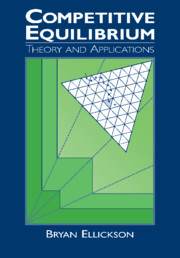7 - Walras meets Nash
Published online by Cambridge University Press: 04 December 2009
Summary
The preceding chapter approached the question of existence of Walrasian equilibrium by searching for prices which clear markets. This chapter explores an alternative approach, no less intuitive, which relies not on the summation of best responses but rather on their Cartesian product. Although the method is most directly associated with the work of Nash on noncooperative games, its roots reach back to Cournot in the early part of the nineteenth century.
The first section presents some basic concepts and existence proofs for equilibria of a noncooperative game and its close relative, an abstract economy. The second section applies these notions to proving existence for the traditional Arrow-Debreu economy. The remaining three sections pursue applications with a more exotic flavor involving equilibrium in the presence of externalities, nonconvexities, and nonordered preferences.
Noncooperative game theory
Nash equilibrium
We begin with a very selective presentation of some features of noncooperative game theory which are relevant to our present purpose.
Game theory has its own particular vocabulary which is rather different from that used to describe a Walrasian economy. The participants in a (noncooperative) game are called players, the choices they make strategies, and the benefits they derive from playing the game payoffs. While the terminology is quite different, by a judicious choice of notation we can highlight the similarities between the description of a game and a Walrasian economy.
Let I = { 1,…, n} denote the set of players in the game. Each player i ∈ I selects a strategysi from a fixed strategy set Si ⊂ L where L is a finite dimensional topological vector space.
- Type
- Chapter
- Information
- Competitive EquilibriumTheory and Applications, pp. 283 - 330Publisher: Cambridge University PressPrint publication year: 1994



